Use of a Modified Twin-Screw Extruder to Develop a High-Strength Tablet Dosage Form
Wet granulation is a size-enlargement process in which a liquid is used to achieve the agglomeration of solid particles. Agglomeration improves particles' tableting properties by rendering them free-flowing, nonsegregating, and suitable for compression (1).
Wet granulation is a size-enlargement process in which a liquid is used to achieve the agglomeration of solid particles. Agglomeration improves particles' tableting properties by rendering them free-flowing, nonsegregating, and suitable for compression (1).
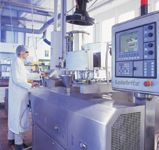
High-shear mixers are widely used for wet granulation and are available in various models and sizes (2, 3). The advantage of these bowl mixers is that mixing, massing, and granulation can all be performed in the same bowl within a few minutes.
High-shear mixing and granulation must be controlled with care, however, because granulation progresses so rapidly that usable granules could very quickly become overmassed and unusable (4). During high-shear granulation, centrifugal forces cause the impeller to throw the sticky wet mass toward the bowl's wall. A large clearance between the impeller edge and the bowl in a Collette Gral mixer–granulator, for example, may cause the wet mass to stick to the wall during the initial phase (5). Researchers also have reported that the wet mass may stick to the bowl lid of a Fielder mixer–granulator. To ensure uniform mixing, the process must be stopped and the walls must be scraped to reintroduce the wet mass into the mixing zone. Wall adhesion has led to broad variation in binder content between individual granules. This variation persists in small granules (6–9) and is problematic because the entire blend must be processed evenly to ensure uniformity within a blend and across batches.
In this study, a modified twin-screw extruder (TSE) was evaluated to develop a 625-mg strength tablet. Conventional high-shear granulation requires a 2:1 drug substance–critical excipient (e.g., calcium silicate) ratio to prevent the formation of a tacky mass. If the 250-mg tablet was linearly scaled-up in the bowl process, it would weigh more than 1500 mg. Higher drug loading or the use of other excipients or binders in the high-shear bowl process would have produced tablets with poor disintegration and dissolution characteristics. Although the spray-dried drug substance had a very low bulk density, the modified TSE could sufficiently densify the drug substance to achieve the target tablet weight that met disintegration and dissolution criteria.
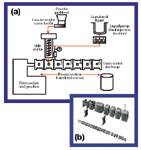
Figure 1: (a) Schematic drawing of a twin-screw extruder process for wet granulation. (b) Barrel arrangement and twin-screw profile.
TSE processes for pharmaceutical applications are not very well documented to date, but they have many potential applications because of their unique design and operating characteristics, including:
- sanitary design: A self-wiping screw design ensures that the material is continuously exchanged on the extruder's metal surfaces to avoid stagnation.
- continuous processing: A production run may continue uninterrupted until completion, thus facilitating process stability and reproducibility.
- small-mass transport: Short, local, mass-transfer distances promote the accurate distribution of small formulation constituents. In contrast, high-shear batch mixers are large mass because process materials are bound by the whole volume of the device. The transport distances to the moving elements and the walls is comparatively larger, causing an accurate distribution of compliments to take more time.
- longitudinal processing: Subprocesses may be sequenced as necessary over the length of the process section (consisting of barrels and screws, see Figure 1) to perform many of the product's manufacturing steps .
- screw interaction: Distributive and dispersive mixing can be enhanced by the flow patterns in the apex region where the two screws come together.
- power through two screws: Shafts transfer high torque and can power a screw length that is long enough for several unit operations (10, 11).
Materials
To evaluate the use of a modified TSE for developing high-strength tablet, the following materials were used: investigational new drug (IND), calcium silicate 250 NF, crospovidone (PVP-XL), colloidal silicon dioxide NF (SiO2), and magnesium stearate NF.
The following pieces of equipment were used: 34-mm and 50-mm TSEs (American Leistritz Corporation, Somerville, NJ); mills (Quadro Comil 196 and 197S, Quadro Engineering, Ontario, Canada); 4- and 16-qt and 5-, 10-, and 75-ft3 twin-shell PK blenders; 24-, 250-, and 500-L bin blenders; tablet presses with 19 and 36 stations (Kikusui, Kyoto, Japan); 12-, 24-, and 60-in. coaters (Accela-Cota, Thomas Engineering, Hoffman Estate, IL); fluid-bed dryers (GPCG 5 and 60, Glatt, Ramsey, NJ; Niro 8, Niro, Columbia, MD); a gravimetric feeder system (K-Tron, Pitman, NJ); a volumetric feeder system (Brabender Technologie, Duisburg, Germany); and a pump (Ivek, North Springfield, VT).
TSE design. As the name implies, TSEs use two screws arranged side by side. Material transport in a TSE depends on the screws' specific configurations, but generally the opposing screw prevents the process material from rotating with the screw. The theory of TSE velocity profiles is not well developed, hence it is difficult to predict proper screw geometry when a certain performance is required for a particular application (12).
This situation has led to the development of modular TSEs that have removable screw-and-barrel elements. The screw profile can be altered by changing the sequence and type of screw elements along the shaft, thus a large number of screw geometries can be put together. The modular design creates tremendous flexibility and enables careful screw-and-barrel geometry optimization.
The basic extruder layout includes a platform that supports a drive system, barrels, screw elements on a screw shaft, and a connection to utilities and controls (see Figure 1). A barrel can include an injection port to introduce the granulating medium, and therefore the injection can be single or multipoint. A typical extrusion process length (L) to diameter (D) range is 24–40:1 (12).
Extruder barrel. The extruder barrel is a flanged cylinder that surrounds the extruder screw (see Figure 2). It can withstand relatively high pressures (≤5000 psi) and has sufficient structural rigidity to minimize sagging or deflection. The extruder barrel can be cooled externally or internally with air or liquid. TSEs dissipate as much as two-thirds of the drive capacity into the product. Therefore, it is essential to absorb this additional energy in a controlled manner.
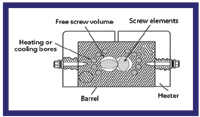
Figure 2: Barrels with internal bores for heating or cooling.
Die. Although it is not required for wet granulation, the die is a very critical part of the extruder in the food and plastics industries because the polymer forms here.
Feed hopper, screw feeders, and force feeder. The feed hopper brings the powder to the extruder. In most cases, gravity makes the material flow from the hopper into the extruder. Some materials have very poor flow characteristics, though. Additional devices may be needed to ensure steady flow into the extruder. During extrusion, liquids and powders must be fed accurately and continuously throughout the run and refill periods to ensure formulation consistency, constant throughput, proper order of mixing ingredients, and regulated mass transfer. At present, screw feeders are the most widely used devices for feeding dry ingredients into extruders (13). A force feeder (or side-stuffer) may also be used in conjunction with screw feeders. They are useful for very low-density and poorly flowing materials.
Screw elements and screw design. Co-rotating and intermeshing TSEs are common for mixing applications because they have a self-wiping action and provide a high degree of mixing and positive conveying (14, 15). Depending on the element's design, screws can convey, mix, or knead the material. The elements are available in various lengths, pitch sizes, and configurations to accommodate variability among powders (e.g., bulk density, flow, material slippage). Designs may be single or multiflighted (see Figure 3). Although several screw designs of individual screw elements are available, there are three basic functional types broadly classified as conveying, mixing, or zoning (see Figure 3). The number and location of the screw elements help define the granulation parameters.

Figure 3: Screw elements (various geometries).
Extruder modifications for continuous wet granulation. To demonstrate whether a co-rotating and intermeshing extruder could be used to develop a high-strength tablet, several equipment modifications were made. The changes included the removal of a die plate (open-ended granulation exit) (see Figure 4); a common feed barrel for a powder blend and binder injection; dual-injection locations; the use of purge barrel to deaerate the preblend (see Figure 4); and the use of both a screw-feeder and side stuffer to increase throughput and screw design modifications (including removing torpedo end-cap units and replacing them with protruding chopper elements) to facilitate conveying, mixing, granulating, and wet-milling in a single step (16).

Figure 4: 34-mm twin-screw extruder (left) screw profile and (right) feeder, side stuffer, multi-injection ports, and vented barrel.
Methods
Preparation of granules. Bulk and tap densities greater than 0.45 and 0.60 g/cm3, respectively, are required to produce a 625-mg strength, 1150-mg tablet. A disintegration time <12 min indicated that the dissolution specification (75% release within 45 min) had been met. The drug substance was blended with calcium silicate in 3:1, 4:1, and 5:1 ratios to determine processibility and granulation characteristics using a modified TSE.
Pilot- and manufacturing-scale studies were performed on 34- and 50-mm TSEs, respectively. Initial experiments were conducted with a feed hopper, which subsequently was replaced with a volumetric screw-feeder for the pilot scale (10–60 kg) batches and with a gravimetric screw-feeder for the manufacturing-scale (900 kg) batches. The amount of granulating liquid was varied over a wide range to determine the optimal moisture level to aid processibility and to achieve the desired tablet characteristics. Single and multiple injection ports were evaluated to determine optimal granulating liquid level and injection locations.

Figure 5: Spray-dried drug substance.
On the basis of preliminary 34-mm TSE experiments, the following reference conditions for the extrusion process were selected: 100-rpm screw speed, 3-kg/h total input rate, and 30% (w/w) water concentration. These reference conditions then were used to optimize the extruder's configuration (feed port location, side-stuffer installation, injection rate and locations, process temperature, type and location of screw elements for optimal screw profile, and screw rpm).
The equipment's maximum capacity at its optimized configuration was assessed using the maximum screw speed (300 rpm) and a water concentration of 30% w/w. Critical process parameters and operating ranges were identified for the manufacture of a robust formulation on the 34-mm extruder. A consistent output of 10 kg/h was achieved for 10–12 h on the pilot-scale equipment. To determine process's efficiency, the granules were evaluated for particle size and bulk and tap densities. The tablets were evaluated for friability, hardness, disintegration, and dissolution. A 60-kg pilot-scale sample and a subsequent clinical batch were manufactured successfully under optimized conditions. The continuous process then was scaled-up to a 50-mm extruder. For the manufacturing scale, three 900-kg batches were successfully made at 50 kg/h output.

Table I: Tablet formulations with various drugâÂÂexcipient ratios.
Formulation. The drug was spray-dried (see Figure 5) and had a low bulk density (0.14 g/cm3) and surface area (1.30 m2/g). The lower strength formulation had a 2:1 drug–calcium silicate ratio (see Table I). Scaling-up this formulation to a 625-mg strength tablet would have produced tablets weighing more than 1500 mg. Calcium silicate was a critical excipient due to a better physical interaction with the drug, thus preventing tacky granule mass formation. Calcium silicate also had low bulk density (0.14 g/cm3), but a larger surface area (92 m2/g). To reduce the tablet size, one must minimize the quantity of calcium silicate while increasing the drug load. The formulation process variables evaluated were drug–calcium silicate ratios and extragranular disintegrant and glidant levels.
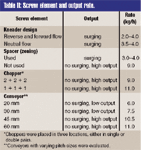
Table II: Screw element and output rate.
Results and discussion
Process variables. Screw elements and profile. The screw elements were evaluated for throughput and consistency (see Table II). Granulation outputs based on various screw profiles also were determined (see Figure 6, Table III). Initial experiments showed periodic surging of the wet mass as it exited the extruder. This effect was attributed to the kneading elements (dispersive mixers) blocking the material and causing a backup in the extruder. Hence, these elements were removed from the screw profile.

Table III: Effect of overall screw profile on granulation output and tablet characteristics.
The new screw profile consisted of only conveying and chopping elements (distributive mixers) (see Figure 6a). This design resulted in a substantial output increase. Nonetheless some surging still occurred. The new screw profile consisting of the zoning (spacer) elements in between the transitioning and torpedo elements as end-cap fittings from the previous design. Spacer elements typically are used when melt extrusion is performed. For the current application, the spacer elements were removed (see Figure 6b). This configuration provided the best output and consistency. Low-density material was carried by conveying elements with a larger pitch relative to the first mixing zone, followed by conveying elements with successively reduced pitch that increased the densification as the wetted mass progressed toward the exit. The placing of the mixer (chopper) elements at the exit ensured the discharge of evenly sized, 1–2-mm wet granules (see Figure 6c).
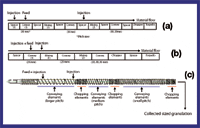
Figure 6: Screw profiles (A) surging, (B) low output, (C) optimized (no surging, high output).
Influence of screw speed (residence time). The output rate as a function of granulator screw rotations per minute (rpm) was studied for the optimized screw profile. Screw speeds of 250, 275, 300, and 350 rpm were evaluated using the 4:1 drug–excipient ratio (see Table IV). As the screw speed increased, the granulation output increased. The feed rate had to be increased to ensure that the screws were filled with incoming material at the same rate as the material exiting the granulator. Because of the preblend's poor flowability, the hopper feeder could not keep up with fast screw rotation rates (>100 rpm). Thus, a screw feeder was installed.

Figure 7: Effect of injection locations on torque.
Effect of screw feeder and side stuffer (force feeder). The screw feeder helped deaerate the powder and feed the preblend more consistently. At a faster screw-feeder rpm (4 kg/h), however, powder built up in the feed zone. To overcome this problem, a side stuffer was used to improve predensification, deaeration, and pressure feeding the powder. This configuration doubled the feed rate and enabled the extruder to operate at faster speeds (>250 rpm).
Effect of injection rate and location. Dual-port injection lowered the torque more than single-port injection (see Figure 7). Single-port injection caused torque excursions (8–29 amps) because of the poor distribution of granulating liquid within the extruder. Dual-port injection eliminated torque excursions (12 amps). Torque decreased (8 amps) when the first injection port was located at the feed zone and the second port was located just before the first pair of mixing elements (see Figure 7).

Table IV: Effect of screw speed on granulation output and tablet characteristics.
Liquid pump setting. Reducing the proportion of injection from 50 to 25% at the first injection port and 75% at the second injection port did not alter output, torque, or granule characteristics such as bulk density (0.49 versus 0.50 g/mL) or tap density (0.66 versus 0.65 g/mL).
Barrel temperature. All experiments were conducted with a 25 °C barrel temperature. During startup of the 34-mm extruder, the barrel containing the first pair of mixing elements registered temperatures as high as 36 °C. After continuously running for 30 minutes, the temperature stabilized to the set point. An experiment was conducted to determine the effect of barrel temperature on the process and product. Increasing all barrel temperatures to a 50 °C set point did not affect the output rate. The bulk (0.50 g/cm3) and tap densities (0.66 g/cm3) were similar to the densities at lower process temperature. The disintegration time for the film-coated tablets was 9 min. The dissolution profile demonstrated that a 50 °C set point did not adversely affect product performance (see Figure 8).
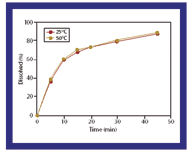
Figure 8: Effect of process temperature on tablet dissolution.
Formulation variables. To achieve a target tablet weight of ~1150 mg, bulk and tap densities more than 0.45 and 0.60 g/cm3, respectively, were needed (the bulk and tap densities of the 4:1 preblend were 0.15 and 0.25 g/cm3, respectively). Tablets were compressed to a 28-kP target hardness and a <1% friability. A <12-min disintegration time indicated that the dissolution specification (75% released within 45 minutes) had been met. Several formulation variables were evaluated to achieve the target specifications.
Drug–calcium silicate ratio. A wide range of drug–calcium silicate ratios could be granulated using the optimized screw-profile on the modified TSE. An increase in the drug proportion reduced the amount of water needed to achieve similar granulation characteristics. Processibility of a range of drug–calcium silicate ratios (3:1, 4:1, and 5:1) indicated the process was robust. For drug–calcium silicate levels <4:1, the target tablet weight was difficult to achieve. All formulations exceeded the dissolution specification (see Table V). Due to downstream processing issues, the 5:1 formulation was rejected. From the formulation variables examined, the 4:1 drug–calcium silicate formulation's performance justified its use as the higher dose formulation (see Figure 9).
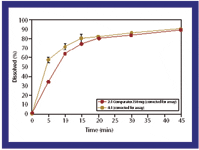
Figure 9: Effect of drugâÂÂexcipient ratio on tablet dissolution.
Level of granulating medium. Because calcium silicate has a large surface area and is hydrophilic, a consistent granulation was obtained over a wide range of liquid levels (moisture range 20–40%) (see Table VI). For scale-up, a middle range (30%) was chosen. To maintain a <10% extruder torque, a pump setting of 50 mL/min was used.
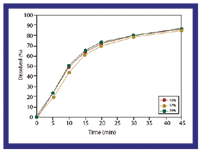
Figure 10: Effect of level of disintegrant (crospovidone) on tablet dissolution.
Evaluation of external excipient level. Various levels of crospovidone and silicon dioxide were evaluated. The milled granulation was subdivided into four sublots and then blended with 15.0% PVP-XL and 0.20% SiO2; 17.0% PVP-XL and 0.20% SiO2; 20% PVP-XL and 0.20% SiO2; or 17.0% PVP-XL and 0.50% SiO2. The tablets were compressed on a rotary press and coated with a 2% clear film coat. A 4:1 drug–calcium silicate ratio and 1.0% magnesium stearate level were maintained. Disintegration and dissolution data are presented in Table VII. The disintegration time decreased with increasing levels of PVP-XL or SiO2. The early time-point drug release slightly increased as the levels of external excipients increased (see Figure 10). The material flow during compression was extremely problematic at higher levels of PVP-XL or SiO2, however. In addition, increased tablet weights associated with higher PVP-XL levels required the tablet press to be operated at near-maximum die cavity fill settings. On the basis of these observations, a standard formulation was selected for scale-up.

Table V: DrugâÂÂcalcium silicate ratios evaluated on the twin-screw extruder.
Pilot-scale clinical tablet manufacture. The formulation containing a 4:1 drug–excipient ratio was selected for clinical studies. The pilot-scale (60-kg) batch was prepared on the 34-mm extruder and the final blend was compressed on a 19-station tablet press using 0.750 × 0.425-in. oval, deep concave punches. Tablet weight, hardness, and friability are reported in Table VIII. Ten kilogram sub-batches of the tablet cores were coated using a 24-in. perforated pan to a theoretical 2% weight gain. Pan speed was maintained at 10 rpm and a 20–40-mL/min spray rate. No sticking, picking, cracking, or twinning were observed during the coating process.

Table VI: Effect of granulating medium level on formulation.
Scale-up and continuous processing. Scale-up using a TSE can be reasonably well predicated and planned for. In general, a better understanding during early research and development helps make scale-up to manufacturing levels smoother. Extruders scale-up volumetrically to approximately the ratio of the cube of their screw diameters. Circular geometry causes free volume to increase much faster. It also is important that equivalent length and diameter be considered for scale-up (see Table IX).

Table VII: Effect of disintegrant level on tablet characteristics.
Specific energy is an important factor in scaling-up the extrusion process because it indicates the amount of energy required to perform a process. Specific energy also is an excellent troubleshooting indicator to determine whether something in the process has changed. The equation for specific energy is as follows:

in which SE is specific energy (kW h/kg); kWm is the kW rating of the motor being used; EG% is the efficiency of the gear system equalling 0.96 (typical gearbox mechanical energy); TS% is the torque used versus the minimum torque; RPM run is the running screw speed; RPM max is the highest screw speed; and Qh is the output rate (kg/h).

Table VIII: Pilot-scale tablet characteristics.
The twin-screw granulator was processed at 50 kg/h for a 900-kg batch on a 50-mm modified TSE (see Figure 11, Table X). No process- or product-related issues were observed. The SE for 34-and 50-mm TSEs were 576 and 622 kW h/kg, respectively. The granule and tablet characteristics are reported in Table XI and Figure 12. The results revealed no significant differences in granule or tablet properties over the entire granulation period. The average residence time (mass flow rate divided by total free volume) of the material in the granulator was 1.68 and 1.38 min for the 34- and 50-mm extruders, respectively.

Table IX: Specifications for 34- and 50-mm extruders (Leistritz, Somerville, NJ).
Conclusion
The modified twin-screw extruder (TSE) successfully produced a high-strength tablet dosage form. Although the drug substance is spray dried and had a very low bulk density, the modified TSE process sufficiently densified the drug substance to achieve the target tablet weight, disintegration, and dissolution specifications.

Figure 11: (a) 50-mm twin-screw extruder, (b) twin-screw profile, (c) torpedo end-cap units replaced by chopping elements, and (d) protruding chopping elements.
Using TSE offers several advantages over other wet granulation processes. The modular nature of the screw elements and the large variety available provide greater flexibility. A small mass processed at any given time, along with short local mass-transfer distances, results in a very controlled and reproducible shear and process history. Scale-up from 10- to 50-kg/h demonstrated that the modified TSE is well suited for scale-up and continuous processing.
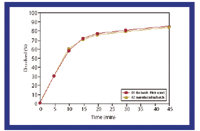
Figure 12: Tablet dissolution profiles of pilot- and manufacturing-scale batches.
One of the most serious challenges to pharmaceutical manufacturing has been the scale-up of batch processes from a development to a production setting. Scale-up issues have been responsible for delaying the commercialization of drug products, thereby costing companies millions of dollars in revenues. Although there has been significant progress in understanding the critical parameters of batch processes, scale-up is still a concern.

Table X: Process conditions for extruders (Leistritz, Somerville, NJ).
The extrusion process is well suited for both scale-up and continuous processing. In most cases, there may not be a need for scaling up from small- to production-size equipment. Because it is continuous, the process only requires longer run times using the same equipment and process parameters to increase the batch sizes. Thus, drug products could be manufactured under the same conditions that are used during clinical efficacy studies and production batches without the need for multiple bioequivalency studies.
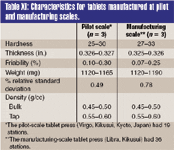
Table XI: Characteristics for tablets manufactured at pilot and manufacturing scales.
Acknowledgment
The author thanks Vanessa Askins for supporting process- and characterization-related activities.
References
1. T. Schaefer and H.G. Kristensen, "A Review of Pharmaceutical Wet Granulation," Drug Dev. Ind. Pharm. 13 (4–5), 803–872 (1987).
2. T. Schaefer et al., "Granulation in Different Types of High-Speed Mixers. Part 2: Comparison Between Mixers," Pharm. Ind. 49 (March), 297–304 (1987).
3. T. Schaefer et al.,"Granulation in Different Types of High-Shear Mixers. Part 1: Effect of Process Variables and Up-Scaling," Pharm. Ind. 48 (9), 1083 (1986).
4. T. Schaefer et al., "Granulation in Different Types of High-Shear Mixers. Part 4: Effect of Liquid Saturation on the Agglomeration," Pharm. Ind. 46 (7), 763 (1984).
5. T. Schaefer, P. Holm, and H.G. Kristensen, "Wet Granulation in a Laboratory Scale High-Shear Mixer," Pharm. Ind. 52 (9), 1147 (1990).
6. M.J. Hounslow et al., "Non-Uniformity of Binder Distribution in High-Shear Granulation," Powder Technol. 140 (3), 203–208 (2004).
7. H. Vromans and K. van den Dries, "Relationship Between Inhomogeneity Phenomena and Granule Growth Mechanisms in a High-Shear Mixer," Int. J. Pharm. 247 (2), 167–177 (2002).
8. T. Instone, M.J. Hounslow, and A.C. Scott, "Direct Evidence of Heterogeneity During High-Shear Granulation," Powder Technol. 113 (1–2), 205–213 (2000).
9. A. Sakr, N.H. Parikh, and W. Kornchankul, "Effect of Process Variables on the Content Uniformity of a Low Dose Drug in a High-Shear Mixer," Pharm. Ind. 62 (4), 305 (2000).
10. D.B. Todd, Ed., Plastics Compounding Equipment and Processing (Hanser, New York, NY, 1998).
11. C. Martin, "Continuous Mixing/Devolatilizing via Twin-Screw Extruders for Drug Delivery Systems," paper delivered at the Interphex Conference, Philadelphia, PA, March 20, 2001.
12. C. Rauwendaal, Ed., Twin-Screw Extruders. Polymer Extrusion (Hanser, New York, NY, 3d ed., 1994).
13. D.H. Wilson, Ed., Gravimetric Feeders. Feeding Technology for Plastics Processing (Hanser, New York, NY, 1998).
14. J.L. White, Ed., Technology of Intermeshing Co-Rotating Twin-Screw Extruders. Twin Screw Extrusion-Technology and Principles (Hanser, New York, NY, 1990).
15. B. Thiele, "Twin-Screw Theory," paper presented at the Twin-Screw Workshop, American Leistritz Extrusion Corporation, Somerville, NJ, Dec. 2000.
16. M. Fessehaie et al., "Continuous Production of Pharmaceutical Granulation," WO0189679 A2, 2003.
Umang Shah, PhD, is a senior principal scientist at Pfizer, Inc., Ann Arbor, MI 48105, tel. 734.622.4934, fax 734.622.7779, umang.shah@pfizer.com.

Drug Solutions Podcast: A Closer Look at mRNA in Oncology and Vaccines
April 30th 2024In this episode fo the Drug Solutions Podcast, etherna’s vice-president of Technology and Innovation, Stefaan De Koker, discusses the merits and challenges of using mRNA as the foundation for therapeutics in oncology as well as for vaccines.
Entering New Domains for 3D Printing of Drug Products
April 6th 20253D printing of personalized medications is currently possible under existing compounding regulations, offering enhanced process control through automation. But new legislation coming in 2025 will allow 3D printing as part of a distributed manufacturing framework.